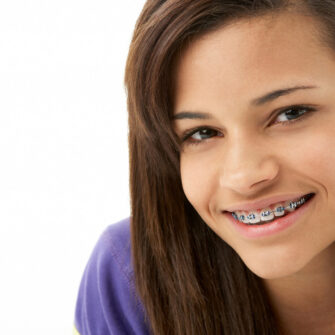Finishing up your orthodontic treatment? Congratulations! You put a lot of effort into reaching this important milestone. To make sure your beautiful new smile lasts a lifetime, you are ready to embark on the next (and arguably most important) stage of your treatment: wearing retainers.
Retainers are amazing little devices that hold your teeth in their new positions while bone tissue rebuilds around them. This process takes time but is essential for stabilizing the teeth. Even after the new bone has solidified, you may need to wear retainers for a longer period to ensure reliable results.
Teeth can move because the bone that holds them in place continually breaks down and rebuilds. During “active” orthodontic treatment, when teeth are being moved, the orthodontist uses braces or aligners to deliver gentle, controlled forces to guide teeth into their proper places.
Nevertheless, natural forces exert pressure on your teeth during activities like biting, chewing, swallowing, and speaking, which can cause them to shift. To counteract these natural forces, orthodontists recommend you continue wearing retainers. While complete prevention of tooth movement may not be possible, wearing retainers as directed is the most effective method to minimize shifting after treatment. It’s important to remember that retainers can only fulfill their purpose when they are in your mouth. Therefore, the success of your treatment hinges on your dedication to wearing your retainers according to the instructions provided by your orthodontist.
Types of Retainers Used After Orthodontic Treatment
Depending on the kind of orthodontic problem that was treated, your AAO orthodontic specialist may suggest a permanent retainer, a removable retainer, or a combination of the two. Once your treatment is complete, your orthodontist will discuss your case to determine which retainer is right for you.
Removable retainers are the most common type provided after orthodontic treatment and can be inserted and removed by the patient. Traditional Hawley retainers are made of wire and a hard, plastic-like material. The part of the retainer that covers the roof of the mouth or goes behind your lower front teeth can be standard-issue pink (like the inside of your mouth) or can be personalized with colors or graphics to make a fun fashion statement. Nearly invisible Essix retainers are available, too, and are made of a transparent, plastic-like material. They are molded from your teeth and resemble clear aligners, making them ideal for those who want an unnoticeable solution.
Permanent or “fixed” retainers are wire devices placed and removed by your orthodontist. Each is custom-fitted and bonded to the tongue-side of your teeth, and unlike removable retainers, are unable to be removed by the patient.
You’ll get a prescription for retainer wear that outlines when to wear them and for how long. For the best orthodontic results, follow your prescription.
If you don’t wear your retainers as prescribed, not only may your teeth move, they may move so much that your retainers won’t fit. If that should happen, contact your orthodontist right away, as more treatment may be required to realign your teeth.
Best Practices for Retainer Care
When not properly cared for, your retainer may deteriorate, change shape, or get lost. If this happens, contact your orthodontist right away, as a malformed or missing retainer will hinder the success of your treatment.
1. Always Use a Retainer Case
No matter where you go, always bring your retainer case. When your removable retainer is not in your mouth, put it in its case right away to avoid losing it. Beyond misplacing your retainer, there are a few other essential reasons to use a case:
- Dropping your retainer into a pocket or purse could damage the device, requiring a new mold at the orthodontist’s office.
- Using a napkin as a replacement case is risky, as it’s very easy to throw it away accidentally. You don’t want to go dumpster diving for your retainer!
- Leaving your retainer out in the open makes it accessible to your pets, and dogs love to chew retainers.
- Even when in a case, avoid heat; your retainer can become damaged if it’s left on a heater, a hot stove, or in a hot car.
2. Keep Your Retainer Clean
When prescribed a retainer, your orthodontist will provide detailed instructions for care and cleaning, including brushing with toothpaste before you put them in or after they are removed. Your doctor may also recommend using an effervescent cleanser to ensure all residue is removed from the retainer.
If you have a permanent retainer, you can brush and floss as normal to maintain retainer cleanliness and oral hygiene. If you find it difficult to brush your retainer, you can use interproximal brushes to reach the nooks and crannies.
3. Be Mindful of Food and Drink
If you have removable retainers, ask your orthodontist if they should be removed before you eat, as some foods or drinks may stain or stick to the device, increasing the risk of gum disease and tooth decay.
If you have an Essix retainer, you may be advised to avoid drinking liquids (except water) when the retainers are in place. Liquids can seep into the retainer, holding the liquid against the teeth until the retainer is removed. Liquids with color (coffee, tea, red wine, etc.) can stain teeth, and those with sugar or acids, such as soft drinks, can cause tooth decay.
The Success of Your Treatment is Up to You
Keeping your smile healthy and beautiful is in your hands. By maintaining home hygiene, visiting your dentist regularly, and wearing your retainers as instructed, you can preserve the great results that came from your orthodontic treatment. If at any time you have a question or concern about your retainers or teeth alignment, contact your orthodontist.
Achieve a Showstopping Smile with an AAO Orthodontist
American Association of Orthodontists (AAO) members have graduated from dental school and gone on to earn a postdoctoral degree specializing in aligning teeth and bites.
When you choose an AAO orthodontist for orthodontic treatment, you can rest assured that you have selected a specialist who possesses the skills and experience to give you your best smile. Locate AAO orthodontists through our Find an Orthodontist page to take the first step toward the smile you’ve always wanted.



